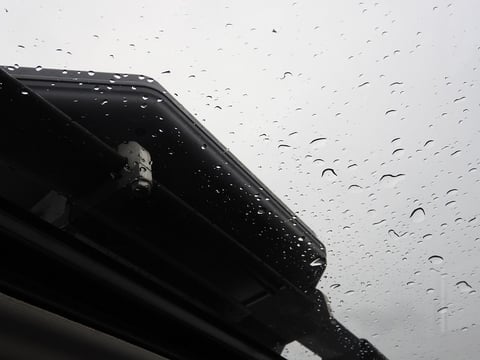PORTLAND, Oregon—Kymeta, the novel satellite antenna company whose investors include Bill Gates, just ended a 7,000-mile trip across the country designed to see how well its technology holds up.
More specifically, Kymeta connected car product manager David Fotheringham wrapped up some 16 days on the road, starting in Washington, D.C., weaving down to Fort Lauderdale, Florida, up through the Midwest, back down to Texas and over to the West Coast, ending in Kymeta’s home town of Redmond, Washington. On the way, they made a pit stop here to meet with local media and donate some toys to Toy & Joy Makers.
Kymeta needs to prove that its KᾹLO service can remain connected everywhere, so Fotheringham drove the Toyota RAV4 equipped with the Kymeta antenna on the roof. The actual device on top of the car is a holographic beam-forming meta material satellite antenna, which is designed so that it can be affordably mass produced, he explained. A laptop was set up so that he could have a YouTube video running in the back seat, keeping tabs on the connection and eyes on the road.

in Portland).
The idea is for a car or other vehicle to be equipped with the proper technology in a matter of minutes, and, presto, it’s a connected car. Kymeta has an agreement with Intelsat for the satellite technology to provide connectivity and a router set up in the back of the car, so it’s basically a mobile Wi-Fi hot spot, which Kymeta provided in partnership with Liberty Global in Puerto Rico.
On a 15-minute road trip across town here in Portland, the connection was up about 90% of the time, but Fotheringham didn’t want to venture a guess on what percentage of time the car stayed connected during the course of the entire nationwide trek. Plenty of data were collected during the trip for later analysis. But basically, the satellite service needs line-of-sight. For instance, Fotheringham stopped for a selfie (and why not?) at the drive-through Redwood tree in northern California, but while in the tree, no line of sight, so no connection.
RELATED: Kymeta takes to the field—and seas—to prove beam-steering technology
While in Florida, Fotheringham set up a Skype video chat with a colleague back in the home office to show the connection being live. He also pointed out that it’s mobile, so it can work on ships as well. Plus, in a market like Florida riveted by storms and hurricanes, it can provide a means of communication that can be rapidly deployed after natural disasters or other emergency situations. When paired with Kymeta KyWay terminals and mTennau7 ASMs, KĀLO services will connect places and fixed and mobile platforms that have traditionally had limited or no connectivity at all.
The thing is, cellular service isn’t on every stretch of highway and back road across the country; there are still dead spots. But where it’s dead, there may be a direct line of sight to a satellite. Here in Portland, the satellite was somewhere over the Pacific Ocean (the system shows the exact longitude), whereas the satellite in Fort Lauderdale was somewhere over the Atlantic Ocean.
Kymeta currently employs more than 160 people, and it’s got a long list of positions it wants to fill.
It’s been a big year for the company. In August, the company provided its satellite-connected car to police in Greenville, South Carolina, during the eclipse, where they were getting speeds of about 7 megabits down and 2.5 megabits per second up. It also provided antenna-equipped vehicles to Puerto Rico after Hurricane Maria.
Last summer, the company was granted blanket authorization from the FCC for commercial distribution of 11,000 of its KyWay terminals in the United States, and it received authorization from Ofcom to provide service to an unlimited number of vehicle-mounted, shipboard and IoT installations in the United Kingdom.

